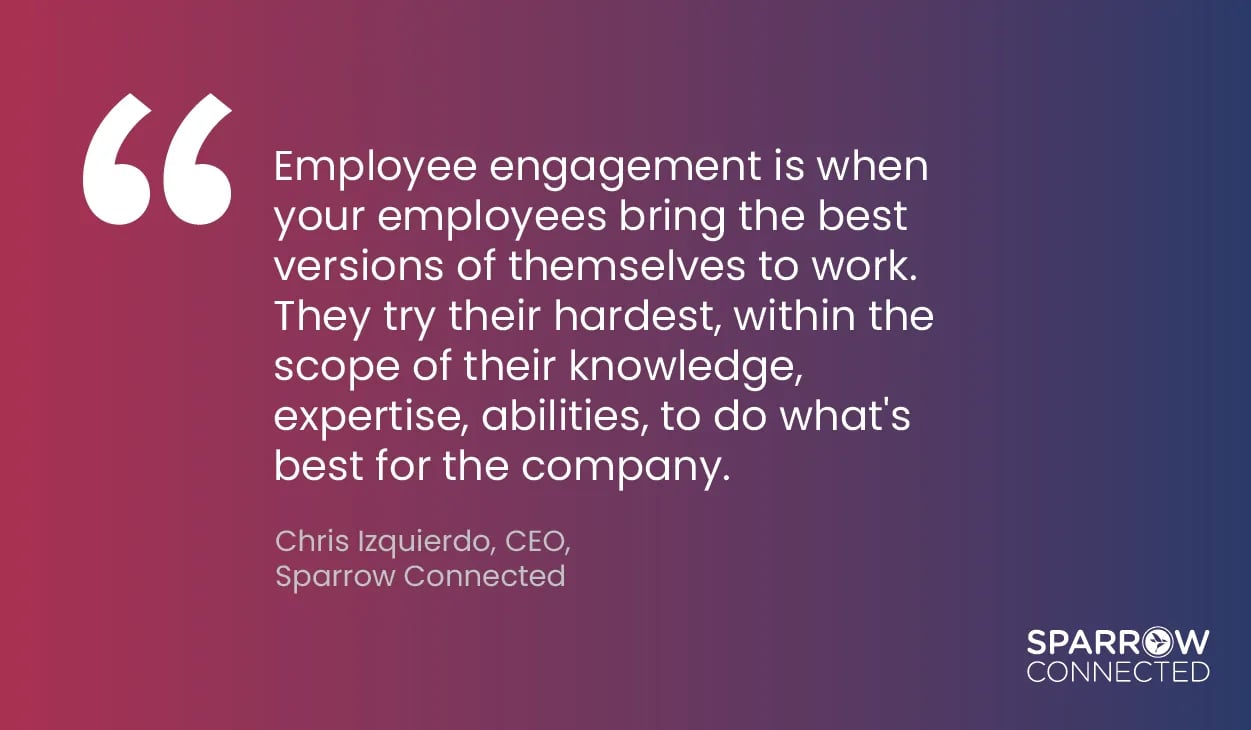A couple weeks ago I wrote a blog called “What is employee engagement anyway?”
My decision to write that blog was triggered by a conversation that I had with an internal communications professional at a manufacturing company who shared that they keep on hearing this term “employee engagement” but hadn’t found a consistent definition of what it is. “Is it just a buzzword?” they asked.
I can tell you that employee engagement is NOT a buzzword. It has a direct impact on productivity which affects your company’s bottom line – especially in the manufacturing sector.
I’ll tell you what employee engagement means to me.
For me, employee engagement is when your employees bring the best versions of themselves to work. They try their hardest, within the scope of their knowledge, expertise, abilities, to do what's best for the company.

When we look at this definition in relation to the manufacturing sector, it becomes pretty easy to identify a manufacturing worker who is not bringing the best version of themself to work.
Disengagement can show up as:
- Frequent absences
- Quality issues
- Slow production
- Short tenure
- Toxic behaviors (negativity, gossip, spreading rumors)
Have you seen any of these signs in your manufacturing workforce? If so, keep reading to learn what employees need in order to be engaged, plus get four tips on what you, as an internal communications professional, can do to help improve engagement.
What do employees need in order to be engaged?
One of the best articles I’ve read on employee engagement so far (and I do a lot of reading) was by Harvard Business Review. In the article, they broke down the many facts of employee engagement. I might be missing one or two based on their definition, but these are the ones that resonated the most with me.
In order for an employee to be engaged, they have to:
- Be challenged, but not too challenged because then they get frustrated
- Have a manager that cares but who also holds them accountable
- Identify with the organization they’re working for
- Feel valued, not like they’re not just another person that can easily be replaced
- Have a defined career path
I like to think of employee engagement as a pie and there is a slice of the pie that belongs to corporate communications. As a communications professional, that slice of the pie is all yours. What will you do with it?
Here are four things I believe internal communications can do to contribute to employee engagement.
1. Be Transparent
It’s really, really important to make sure that employees identify with your mission, vision and core values and know that you're a transparent organization - from the boardroom to the frontlines. Employees need to feel like they can trust the company and have a clear understanding of what the company is doing and why they’re doing it.
I read about a Brazilian company that outperformed its peers 10 to 1 - performance that is an order of magnitude better. This significant outperformance is based on the simple principle of transparency. The CEO shared every single piece of information. Every meeting was documented and shared with the entire organization. Employees could see the discussions happening and decisions made at the board level. They even went as far as to publish everyone’s salaries. None of this would have been possible in the absence of good communication.
2. Become The Source of Truth
The way I see it, corporate communications is the glue that holds the organization together. What I mean by this is, if things that happen in the organization are not communicated or are communicated poorly, employees will make up their own stories and the rumor mill will start running. With manufacturing being in-person, the rumors can spread even faster than in remote work environments. To prevent this, internal communications need to ensure that accurate information is being shared and be the source of truth for important news and information.
3. Create Content Employees Crave
We have a customer who, prior to adopting Sparrow Connected, was producing a lot of content for their manufacturing workers. When they finally started looking at their content engagement metrics, they realized that no one was actually engaging with the content. Of 2,500 employees, each article was getting about 10 reads on average. They quickly realized they were wasting their time. It doesn't matter how much content you create if no one is engaging with it.
Internal comms teams need to produce the news and information that employees crave and deliver it to the channels they actually use. Content that aligns with what they’re actually looking for, not what comms thinks they're looking for.
One way to understand what your employees are craving is by looking at content engagement metrics.
- What are employees showing interest in?
- What are they NOT showing interest in?
- What are they searching for?
- Where are they consuming content?
- What are the comments about?
Use what you learn from looking at these metrics to inform your communications strategy.
4. Align With Employee Influencers
Another way of gathering intel to inform your content production is by connecting with the influencers on the manufacturing floor. You’ll need to spend time in-person identifying and connecting with these people. They’re the ones who naturally connect people and they hold the power of the conversations that are happening on the floor and in the break rooms. Internal communications needs to listen to these influencers in order to better understand manufacturing employees’ needs, concerns and preferences then use the intel to guide strategy and content development.
Going back to my definition of employee engagement: employees are engaged when they bring the best versions of themselves to work. As I shared, there are a number of factors that contribute to an employee bringing the best version of themself to work (and I only scratched the surface). Many of these factors are beyond your control as an internal communications professional, but one of them is entirely within your control and that is the way you communicate with employees. Remember, you own the communications slice of the employee engagement pie.
What’s Next:




